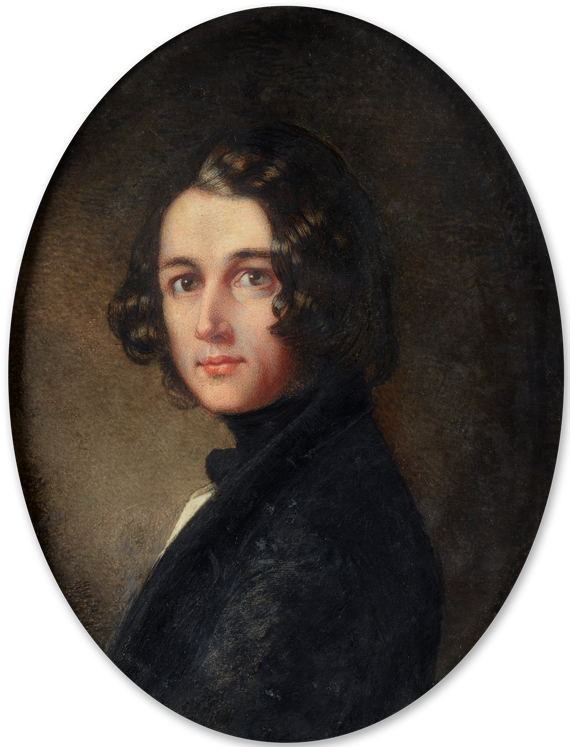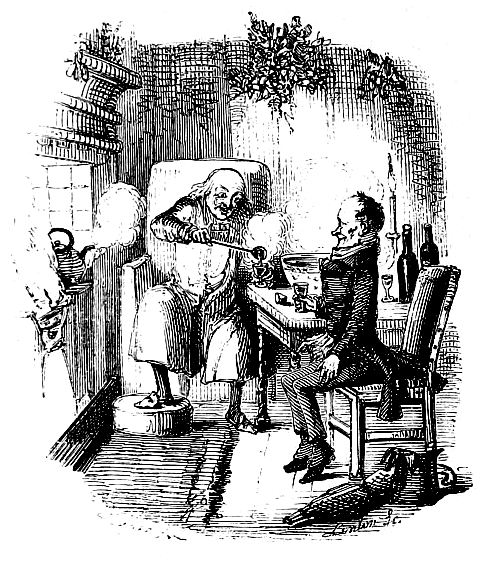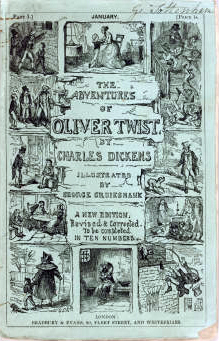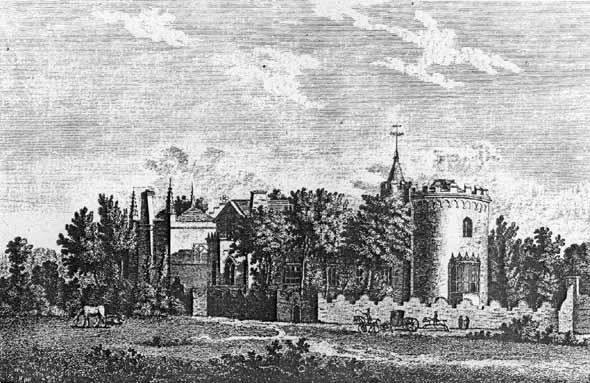|
Ghost Of Christmas Yet To Come
The Ghost of Christmas Yet to Come is a fictional character in Charles Dickens's 1843 novella ''A Christmas Carol''. The Ghost is the last of the three spirits that appear to miser Ebenezer Scrooge to offer him a chance of redemption, foretold by the ghost of his deceased business partner, Jacob Marley. Following a visit from the ghost of his deceased business partner, Jacob Marley, Scrooge receives nocturnal visits from three Ghosts of Christmas, each representing a different period in Scrooge's life. The shrouded, ominous, and silent Ghost of Christmas Yet to Come is Scrooge's last visitor and shows him a vision of a Christmas Day soon after his death. Background By early 1843, Dickens had been affected by the treatment of the poor, and in particular the treatment of the children of the poor after witnessing children working in appalling conditions in a tin mine and following a visit to a ragged school. Indeed, Dickens experienced poverty as a boy when he was forced to w ... [...More Info...] [...Related Items...] OR: [Wikipedia] [Google] [Baidu] |
A Christmas Carol
''A Christmas Carol. In Prose. Being a Ghost Story of Christmas'', commonly known as ''A Christmas Carol'', is a novella by Charles Dickens, first published in London by Chapman & Hall in 1843 and illustrated by John Leech. It recounts the story of Ebenezer Scrooge, an elderly miser who is visited by the ghost of his former business partner Jacob Marley and the spirits of Christmas Past, Present and Yet to Come. In the process, Scrooge is transformed into a kinder, gentler man. Dickens wrote ''A Christmas Carol'' during a period when the British were exploring and re-evaluating past Christmas traditions, including carols, and newer customs such as cards and Christmas trees. He was influenced by the experiences of his own youth and by the Christmas stories of other authors, including Washington Irving and Douglas Jerrold. Dickens had written three Christmas stories prior to the novella, and was inspired following a visit to the Field Lane Ragged School, one of sev ... [...More Info...] [...Related Items...] OR: [Wikipedia] [Google] [Baidu] |
John Forster (biographer)
John Forster (2 April 1812 – 2 February 1876) was an English writer and biographer. He was best known for publishing ''The Life of Charles Dickens'' (1872), which was the first biography published of Charles Dickens after his death in 1870. He was a personal friend of Dickens and part of Dickens's social circle, which included William Makepeace Thackeray, Wilkie Collins and Hans Christian Andersen. Life Forster was born at "a little yellow house" in Fenkle Street, Newcastle upon Tyne, second of four children of Unitarianism, Unitarian cattle-dealer Robert Forster (died 1836) and Mary (c. 1780-1852), daughter of a Newcastle_City_Centre#Gallowgate, Gallowgate dairy farm keeper. Forster's great-grandfather had been "a man of some considerable substance", a landowner at Corsenside in Northumberland; his grandfather Christopher (the third son) inherited nothing, so this branch became butchers and cattle-dealers in Newcastle. Forster's father "married beneath himself" despite his wif ... [...More Info...] [...Related Items...] OR: [Wikipedia] [Google] [Baidu] |
The Mystery Of Edwin Drood
''The Mystery of Edwin Drood'' is the final novel by English author Charles Dickens, originally published in 1870. Though the novel is named after the character Edwin Drood, it focuses more on Drood's uncle, John Jasper, a precentor, choirmaster and opium addict, who lusts after his pupil, Rosa Bud. Miss Bud, Edwin Drood's fiancée, has also caught the eye of the high-spirited and hot-tempered Neville Landless. Landless and Edwin Drood take an instant dislike to each other. Later Drood disappears under mysterious circumstances. The story is set in Cloisterham, a lightly disguised Rochester. At the death of Dickens on 9 June 1870, the novel was left unfinished in his writing desk, only six of a planned twelve instalments having been written. He left no detailed plan for the remaining instalments or solution to the novel's mystery, and many later adaptations and continuations by other writers have attempted to complete the story. Summary The novel begins as John Jasper leav ... [...More Info...] [...Related Items...] OR: [Wikipedia] [Google] [Baidu] |
Great Expectations
''Great Expectations'' is the thirteenth novel by English author Charles Dickens and his penultimate completed novel. The novel is a bildungsroman and depicts the education of an orphan nicknamed Pip. It is Dickens' second novel, after ''David Copperfield'', to be fully narrated in the first person.''Bleak House'' alternates between a third-person narrator and a first-person narrator, Esther Summerson, but the former is predominant. The novel was first published as a serial in Dickens's weekly periodical '' All the Year Round'', from 1 December 1860 to August 1861. In October 1861, Chapman & Hall published the novel in three volumes. The novel is set in Kent and London in the early to mid-19th century and contains some of Dickens's most celebrated scenes, starting in a graveyard, where the young Pip is accosted by the escaped convict Abel Magwitch. ''Great Expectations'' is full of extreme imagery—poverty, prison ships and chains, and fights to the death—and has a colour ... [...More Info...] [...Related Items...] OR: [Wikipedia] [Google] [Baidu] |
Bleak House
''Bleak House'' is a novel by English author Charles Dickens, first published as a 20-episode Serial (literature), serial between 12 March 1852 and 12 September 1853. The novel has many characters and several subplots, and is told partly by the novel's heroine, Esther Summerson, and partly by an omniscient narrator. At the centre of ''Bleak House'' is a long-running legal case in the Court of Chancery, ''Jarndyce and Jarndyce'', which comes about because a testator has written several conflicting wills. In a preface to the 1853 first edition, Dickens said there were many actual precedents for his fictional case. One such was probably ''Thellusson v Woodford'', in which a will read in 1797 was contested and not determined until 1859. Though many in the legal profession criticised Dickens's satire as exaggerated, ''Bleak House'' helped support a judicial reform movement that culminated in the enactment of Judicature Acts, legal reform in the 1870s. Some scholars debate when ''Ble ... [...More Info...] [...Related Items...] OR: [Wikipedia] [Google] [Baidu] |
Oliver Twist
''Oliver Twist; or, The Parish Boy's Progress'', is the second novel by English author Charles Dickens. It was originally published as a serial from 1837 to 1839 and as a three-volume book in 1838. The story follows the titular orphan, who, after being raised in a workhouse, escapes to London, where he meets a gang of juvenile pickpockets led by the elderly criminal Fagin, discovers the secrets of his parentage, and reconnects with his remaining family. ''Oliver Twist'' unromantically portrays the sordid lives of criminals and exposes the cruel treatment of the many orphans in England in the mid-19th century. The alternative title, ''The Parish Boy's Progress'', alludes to Bunyan's '' The Pilgrim's Progress'' as well as the 18th-century caricature series by painter William Hogarth, '' A Rake's Progress'' and '' A Harlot's Progress''. In an early example of the social novel, Dickens satirises child labour, domestic violence, the recruitment of children as criminals, and t ... [...More Info...] [...Related Items...] OR: [Wikipedia] [Google] [Baidu] |
Gothic Literature
Gothic fiction, sometimes referred to as Gothic horror (primarily in the 20th century), is a literary aesthetic of fear and haunting. The name of the genre is derived from the Renaissance era use of the word "gothic", as a pejorative to mean medieval and barbaric, which itself originated from Gothic architecture and in turn the Goths. The first work to be labelled as Gothic was Horace Walpole's 1764 novel ''The Castle of Otranto'', later subtitled ''A Gothic Story''. Subsequent 18th-century contributors included Clara Reeve, Ann Radcliffe, William Thomas Beckford, and Matthew Lewis. The Gothic influence continued into the early 19th century, with Romantic works by poets, like Samuel Taylor Coleridge and Lord Byron. Novelists such as Mary Shelley, Charles Maturin, Walter Scott and E. T. A. Hoffmann frequently drew upon gothic motifs in their works as well. Gothic aesthetics continued to be used throughout the early Victorian period in novels by Charles Dickens, Brontë si ... [...More Info...] [...Related Items...] OR: [Wikipedia] [Google] [Baidu] |
Gothic Fiction
Gothic fiction, sometimes referred to as Gothic horror (primarily in the 20th century), is a literary aesthetic of fear and haunting. The name of the genre is derived from the Renaissance era use of the word "gothic", as a pejorative to mean medieval and barbaric, which itself originated from Gothic architecture and in turn the Goths. The first work to be labelled as Gothic was Horace Walpole's 1764 novel ''The Castle of Otranto'', later subtitled ''A Gothic Story''. Subsequent 18th-century contributors included Clara Reeve, Ann Radcliffe, William Beckford (novelist), William Thomas Beckford, and Matthew Gregory Lewis, Matthew Lewis. The Gothic influence continued into the early 19th century, with Romantic works by poets, like Samuel Taylor Coleridge and Lord Byron. Novelists such as Mary Shelley, Charles Maturin, Walter Scott and E. T. A. Hoffmann frequently drew upon gothic motifs in their works as well. Gothic aesthetics continued to be used throughout the early Victorian li ... [...More Info...] [...Related Items...] OR: [Wikipedia] [Google] [Baidu] |
History Today
''History Today'' is a history magazine. Published monthly in London since January 1951, it presents authoritative history to as wide a public as possible. The magazine covers all periods and geographical regions and publishes articles of traditional narrative history alongside new research and historiography. History The magazine was founded after the Second World War, by Brendan Bracken, former Minister of Information, chairman of the ''Financial Times'' and close associate of Sir Winston Churchill. The magazine has been independently owned since 1981. The founding co-editors were Peter Quennell, a "dashing English man of letters", and Alan Hodge, former journalist at the ''Financial Times''. The website contains all the magazine's published content since 1951. A digital edition, available on a dedicated app, was launched in 2012 and re-released with improvements in 2015. ''History Review'' was a tri-annual sister publication of ''History Today'' magazine publishing mate ... [...More Info...] [...Related Items...] OR: [Wikipedia] [Google] [Baidu] |
Paranormal
Paranormal events are purported phenomena described in popular culture, folk, and other non-scientific bodies of knowledge, whose existence within these contexts is described as being beyond the scope of normal scientific understanding. Notable paranormal beliefs include those that pertain to extrasensory perception (for example, telepathy), spiritualism and the pseudosciences of ghost hunting, cryptozoology, and ufology. Proposals regarding the paranormal are different from scientific hypotheses or speculations extrapolated from scientific evidence because scientific ideas are grounded in empirical observations and experimental data gained through the scientific method. In contrast, those who argue for the existence of the paranormal explicitly do not base their arguments on empirical evidence but rather on anecdote, testimony and suspicion. The standard scientific models give the explanation that what appears to be paranormal phenomena is usually a misinterpretation ... [...More Info...] [...Related Items...] OR: [Wikipedia] [Google] [Baidu] |
Victorian Era
In the history of the United Kingdom and the British Empire, the Victorian era was the reign of Queen Victoria, from 20 June 1837 until her death on 22 January 1901. Slightly different definitions are sometimes used. The era followed the Georgian era and preceded the Edwardian era, and its later half overlaps with the first part of the ''Belle Époque'' era of continental Europe. Various liberalising political reforms took place in the UK, including expanding the electoral franchise. The Great Famine (Ireland), Great Famine caused mass death in Ireland early in the period. The British Empire had relatively peaceful relations with the other great powers. It participated in various military conflicts mainly against minor powers. The British Empire expanded during this period and was the predominant power in the world. Victorian society valued a high standard of personal conduct across all sections of society. The Victorian morality, emphasis on morality gave impetus to soc ... [...More Info...] [...Related Items...] OR: [Wikipedia] [Google] [Baidu] |
Novella
A novella is a narrative prose fiction whose length is shorter than most novels, but longer than most novelettes and short stories. The English word ''novella'' derives from the Italian meaning a short story related to true (or apparently so) facts. Definition The Italian term is a feminine of ''novello'', which means ''new'', similarly to the English word ''news''. Merriam-Webster defines a novella as "a work of fiction intermediate in length and complexity between a short story and a novel". There is disagreement regarding the number of pages or words necessary for a story to be considered a novella, a short story or a novel. The Science Fiction and Fantasy Writers Association defines a novella's word count to be between 17,500 and 40,000 words; at 250 words per page, this equates to 70 to 160 pages. See below for definitions used by other organisations. History The novella as a literary genre began developing in the Italian literature of the early Renaissance, princip ... [...More Info...] [...Related Items...] OR: [Wikipedia] [Google] [Baidu] |








